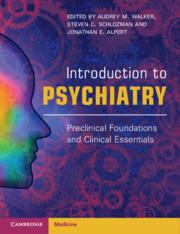Book contents
- Introduction to Psychiatry
- Introduction to Psychiatry
- Copyright page
- Contents
- Contributors
- 1 Introduction
- 2 Clinical Neuroscience
- 3 Introduction to the Patient Interview
- 4 Mood Disorders
- 5 Schizophrenia Spectrum and Other Psychotic Disorders
- 6 Anxiety Disorders
- 7 Obsessive-Compulsive and Related Disorders
- 8 Disorders Related to Stress and Trauma
- 9 Substance Use Disorders
- 10 Personality Disorders
- 11 Neurocognitive Disorders
- 12 Feeding and Eating Disorders
- 13 Child Psychiatry and Neurodevelopmental Disorders
- 14 Sleep Disorders
- 15 Psychopharmacology and Neurotherapeutics
- 16 Psychosocial Interventions
- 17 Psychiatric Evaluation in the Medical Setting
- 18 Psychiatry of Gender and Sexuality
- 19 Health Policy and Population Health in Behavioral Health Care in the United States
- 20 Global Health and Mental Health Care Delivery in Low-Resource Settings
- Index
- References
10 - Personality Disorders
Published online by Cambridge University Press: 22 July 2021
- Introduction to Psychiatry
- Introduction to Psychiatry
- Copyright page
- Contents
- Contributors
- 1 Introduction
- 2 Clinical Neuroscience
- 3 Introduction to the Patient Interview
- 4 Mood Disorders
- 5 Schizophrenia Spectrum and Other Psychotic Disorders
- 6 Anxiety Disorders
- 7 Obsessive-Compulsive and Related Disorders
- 8 Disorders Related to Stress and Trauma
- 9 Substance Use Disorders
- 10 Personality Disorders
- 11 Neurocognitive Disorders
- 12 Feeding and Eating Disorders
- 13 Child Psychiatry and Neurodevelopmental Disorders
- 14 Sleep Disorders
- 15 Psychopharmacology and Neurotherapeutics
- 16 Psychosocial Interventions
- 17 Psychiatric Evaluation in the Medical Setting
- 18 Psychiatry of Gender and Sexuality
- 19 Health Policy and Population Health in Behavioral Health Care in the United States
- 20 Global Health and Mental Health Care Delivery in Low-Resource Settings
- Index
- References
Summary
At the turn of the twenty-first century, our understanding of personality disorders radically evolved as research on their biological characteristics and effective evidence-based treatments (EBTs) emerged to challenge preexisting notions of these syndromes as defensive, psychologically determined, and untreatable. Reflecting the turmoil of a paradigm shift, intense controversy raged in attempts to revise the diagnostic system for personality disorders in the transition from the DSM-IV to the DSM-V. Proposed changes included both the elimination of five of the ten existing DSM personality disorders (narcissistic, histrionic, schizoid, paranoid, and dependent) and the implementation of a complex diagnostic system involving the evaluation of both categorical prototypes and dimensional traits of personality. The extremity of these proposed changes in the diagnostic system provoked major opposition among prominent experts, ultimately leading to the retention of the existing set of personality disorder criteria and relegation of the proposed alternative model to a section calling for further research. One prominent change in the transition to the fifth edition of DSM was the elimination of the multi-axial system, ending the segregation of Axis II disorders from Axis I disorders.
- Type
- Chapter
- Information
- Introduction to PsychiatryPreclinical Foundations and Clinical Essentials, pp. 233 - 262Publisher: Cambridge University PressPrint publication year: 2021



